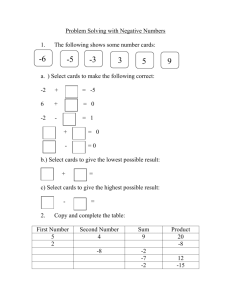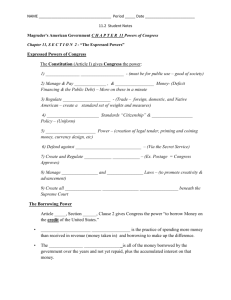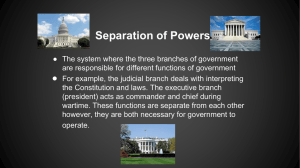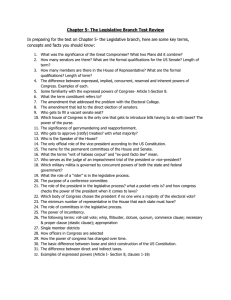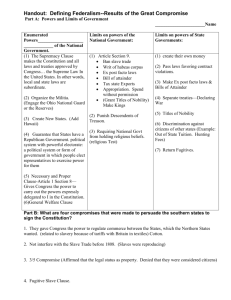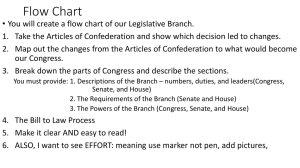Detailing the Powers of Congress
advertisement
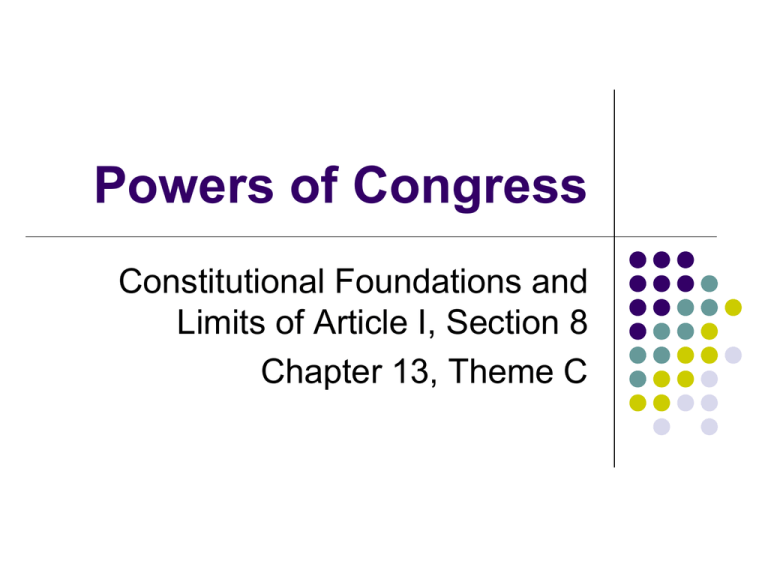
Powers of Congress Constitutional Foundations and Limits of Article I, Section 8 Chapter 13, Theme C What’s the Difference Between Expressed and Implied? Expressed Powers Expressed means that they are explicitly written in the Constitution, giving Congress the direct power to regulate those areas Found primarily in Article I, section 8 for Congress. Implied Powers Implied means that they are powers taken by Congress through reasonable deduction from the expressed powers Found in the “Necessary and Proper” Clause (A1,S8, C18) Article I, Section 8, Clause 18 To make all Laws which shall be necessary and proper for carrying into Execution the foregoing Powers, and all other Powers vested by this Constitution in the Government of the United States, or in any Department or Officer thereof. Called the Elastic Clause and is the source of Congressional implied powers. Allows document to be flexible without formal amendments. Test cases include McCulloch v. MD. Article I, Section 8, Clause 1 The Congress shall have Power To lay and collect Taxes, Duties, Imposts and Excises, to pay the Debts and provide for the common Defence and general Welfare of the United States; but all Duties, Imposts and Excises shall be uniform throughout the United States; Is source of Congressional “Powers of the Purse.” One of most controversial parts to Anti-Federalists. Federal taxes today include income, corporate, inheritance, excise, capital gain and gift taxes, as well as tariffs & custom duties. This clause was tested by Pollack vs. Farmers Trust The power to lay and collect taxes Expressed “To lay and collect Taxes, Duties, Imposts and Excises, to pay the Debts and provide for the common Defense and general Welfare of the United States…” Congress is the only body in the Fed. Gov’t to decide how to tax us Implied Punish Tax Evaders Regulate certain things (alcohol) and outlaw others (narcotics) Require states to meet certain conditions to get federal funding Article I, Section 8, Clause 2 To borrow money on the credit of the United States; Also part of Congressional “powers of purse.” When Congress fails to raise enough revenue, money must be borrowed…this is what has led to our $18 Trillion debt! Borrow money through issuance of US Securities like savings & treasury bonds. Laws concerning Bankruptcies (1.8.4) are also part of the powers of the purse. The Power to Borrow Money Expressed “to borrow money on the credit of the United States” No limit on how much we can borrow No limitations on the reasons for borrowing Implied The power to establish the Federal Reserve System of Banks Article I, Section 8, Clause 3 To regulate Commerce with foreign Nations, and among the several States, and with the Indian Tribes; Called the Commerce Clause, most tested clause. Remember from chapter 3 that the line of interstate has been greatly blurred. Key test cases include: Gibbons v. Ogden Heart of Atlanta Motel v. US US v. Lopez The Power to Regulate Interstate Commerce Expressed “to regulate Commerce with foreign Nations, and among the several states, and with the Indian Tribes” The Congress can make laws regulating domestic and foreign trade Cannot favor one state over another implied Establish a minimum wage Ban discrimination in workplaces and public facilities Pass laws protecting the disabled Regulate Banking Article I, Section 8, Clauses 11-15 To declare War, grant Letters of Marque and Reprisal, and make Rules concerning Captures on Land and Water; To raise and support Armies, but no Appropriation of Money to that Use shall be for a longer Term than two Years; To provide and maintain a Navy; To make Rules for the Government and Regulation of the land and naval Forces; To provide for calling forth the Militia to execute the Laws of the Union, suppress Insurrections and repel Invasions; To provide for organizing, arming, and disciplining, the Militia, and for governing such Part of them as may be employed in the Service of the United States, reserving to the States respectively, the Appointment of the Officers, and the Authority of training the Militia according to the discipline prescribed by Congress; Article I, Section 8, Clauses 11-15 (Continued) These powers are the most misunderstood powers of Congress. President most often wages war without official declarations (Korea, Vietnam, Somalia, Iraq, Afghanistan, etc.) Congress passed War Powers Resolution to curb abuse and to regain authority. Tied to Clause 1! Requires Congressional approval of action or funding is removed for conflict. The Power to Raise an Army and Navy Expressed Congress alone has the power to raise and support an Army and Navy Implied The power to draft Americans into the military Make rules governing our military Declare War Highly controversial, but upheld by Supreme Court in 1917 Article I, Section 8, Clause 9 To constitute Tribunals inferior to the supreme Court; Congress has created the entire structure of the federal court system except the Supreme Court. Began with the Judiciary Act of 1789. Marbury v. Madison arose from this legislation. This power gives Congress authority over types, jurisdictions & sizes of the lower courts. Other Legislative Powers in Art. I, Sec. 8 Rules of Naturalization (1.8.4) Coin Money and fix the Standard of Weights and Measures (1.8.5) Punishment of counterfeiting (1.8.6) Establishment of Post Offices (1.8.7) Issuance of patents & copyrights (1.8.8) Piracies & Felonies committed on high Seas (1.8.10) Management of District of Columbia (1.8.17) The Power to Create Naturalization Laws Expressed “To establish an uniform Rule of Naturalization.” Congress set up the process for immigrants becoming citizens Implied The power to regulate and limit immigration Quotas are placed on the number of people that can immigrate here every year The Power to Establish Post Offices Expressed “to establish Post Offices and Post roads” Implied Prohibit mail fraud and obstruction of the mail Provides for the carrying of the mail “Post Roads” include rail lines, airways, and waters in US while mail is travelling on them Bar the shipping of certain items through the mail Other Powers of the Senate (2.2.2) All treaties negotiated by the President must be approved by 2/3 of the Senate. All diplomats, cabinet members, and other high ranking executive branch officials must be confirmed by a majority of the Senate. All federal judges and justices must be approved by a majority of the Senate. A specific power given to the HOR instead of the Senate is the power to introduce appropriation bills. (1.7.1) Non-Legislative Powers: Choosing a Pres. & V. Pres. Process changed and outlined by Amendment 12. Choosing a President if no one candidate wins a majority of Electoral Votes is a power of the HOR. Each state gets 1 vote and must have a quorum present both for members and states. Choosing a Vice President is a power of the Senate. Same rules as above applies. Has not occurred since the election of 1876. Non-Legislative Powers: Impeachment Process is outlined in Article 1, sections 2 & 3. Impeachment reasons in Art. 2.4. HOR has sole power to impeach members of executive & judicial branches. Takes simple majority to impeach. (Has happened 19 times) http://en.wikipedia.org/wiki/Impeachment_in_the_United_States Senate has the power to convict & remove. Takes 2/3 vote. (Has happened 8 times) The Chief Justice presides over the trial. Supreme Court cannot review. (Nixon v. US) Non-Legislative Powers: Proposing Constitutional Amendments Found in Article 5 of the Constitution. Takes 2/3 majority of both houses to send to the states for ratification. (Takes ¾ of states) Many amendments have been proposed, only 27 have been ratified. Examples recently that failed include a balanced budget amendment and an amendment to outlaw flag burning. 2 provisions cannot be amended: Slave trade before 1808 & the composition of the Senate. Other Powers of Congress Power to investigate (Hearings) Legislative Oversight Legislative Veto Power over Exec Branch & agencies which includes authority to review, monitor, & supervise agencies, programs, activities, & policy implementation. Examples? Power to nullify executive action by Congress Ruled unconstitutional (Chadha v. INS) Speech & Debate Clause Allows immunity from suits against speech (A1,S6) Applies only to floor (Proxmire v. Hutchinson) Assignment: Due Thursday Read pp. 343-350. Take notes on Party structure and leadership. Outline definition, purposes and examples of caucuses. Detail the committee system, its purpose & structure. Be working on research phase of E-Congress simulation. Due Friday.
